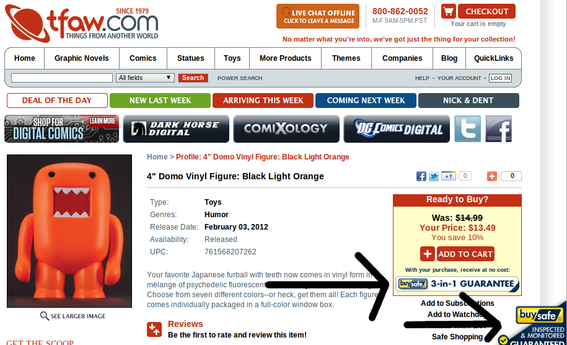A pay-per-click landing page should be a sales conversion engine, tuned to help consummate an order.
Landing pages “are one of the strongest tools you have to convert visitors to customers,” wrote Brandon Eley and Shayne Tilley in their book, Online Marketing Inside Out. “Much of your marketing activity will be geared around attracting visitors to these pages, so the way you construct these will have a significant impact on your income.”
Personalize for Continuity
When a person clicks on a pay-per-click ad, he or she expects that whatever the ad promised will be delivered on the next page — the PPC landing page. For example, on February 27, 2012, FactoryOutletStore.com promoted a two-day sale on Garmin global positioning systems, offering up to 75 percent off.
FactoryOutletStore.com promised up to 75 percent off on Garmin GPSs in its pay-per-click ad.
The associated landing page reiterated the offer with a large banner, as follows.
FactoryOutletStore.com’s landing page offered continuity with its pay-per-click ad, emphasizing the 75 percent off.
There are a few ways to achieve this sort of ad-to-page continuity.
- Create a custom landing page for each ad campaign. Using a platform’s user interface to make the page and then copying and pasting the url.
- Use a server-side scripting language like PHP, Ruby, Java, or similar to add or change landing page content. In this case, a web developer would have the script get variables from the URL and change the page content to ensure continuity.
- Use JavaScript to add or change landing page content. Here a web developer writes a JavaScript that adds content to the page to promote continuity.
Create a Clear Path to the Sale
Pay-per-click landing pages should be single minded in content and layout. The sole goal for these pages is to make as clear a path to the sale as possible, providing all of the information necessary for a buying decision, but nothing more.
“You should ensure that everything on your landing page is focused on encouraging [one primary objective] to be met — images, text, even the layout should help encourage the user to act,” wrote Eley and Tilley. “Your visitor should find it easy to understand what it is that you want them to do.”
Consider placing “add to cart” buttons near the top of the page. Use large, bright buttons, and try to place the buttons in more than one place. Also experiment with product image placement, reviews, and video.
Be Trustworthy
Landing pages should provide visual clues indicating that a merchant is trustworthy. This can be accomplished in few ways, including a professional looking website design, high quality graphics, and trust seals.
As an example, Things from Another World, a comic book retailer, combines good graphics, a modern site design, and seals from BuySafe on its landing page to help make shoppers feel comfortable making a purchase.
Things from Another World uses a trust seal and solid site design to convey trust.
Summing Up
Improving a landing page’s conversion rate even marginally can make a merchant much more profitable and the pay-per-click advertising more effective. Unfortunately, there is not one perfect recipe that every merchant can apply to every PPC campaign. But focusing on ad-to-page continuity, offering a clear path or clear call to action, and building trust, should help optimize pay-per-click landing pages for more sales.




